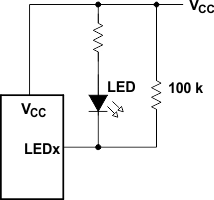Tool/software:
Hello, I'm using LSF0204D to control LED.
But I have a trouble where the LED turns ON very weakly even when it should be completely OFF.
So, I'd like to know the cause of the issue.
In my design, Vref_A is 1.8V and Vref_B is 5V.
A control input signal (push-pull) is connected to A port, and the output signal from B port drives the LED. LED is connected to 5V through a pull-up resistor.
When the control signal is low, LSF0204D FET is ON and the LED turns ON correctly.
But when the control signal is high, LSF0204D FET is OFF and the LED still turns ON very weakly.
With the measured voltage of the B port pin, it seems that B port accepts about 50uA current even when the FET is OFF.
I'd like to know whether 50uA is reasonable value or not.
If the "IIH" in the datasheet is the definition of the leak current, it should be less than 5uA.
Is my understanding correct?
Thank you very much in advance.




